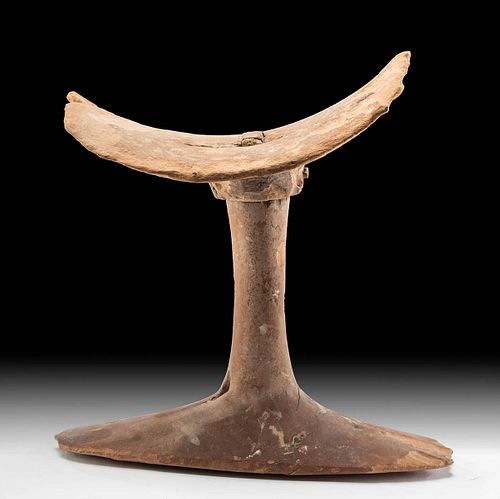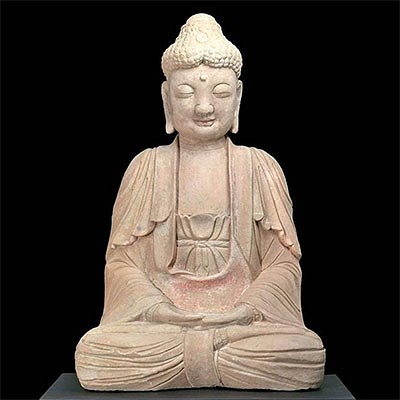Egyptian Middle Kingdom Wood Head Rest
Lot 7a
About Seller
Artemis Fine Arts
686 S Taylor Ave, Ste 106
Louisville, CO 80027
United States
Selling antiquities, ancient and ethnographic art online since 1993, Artemis Gallery specializes in Classical Antiquities (Egyptian, Greek, Roman, Near Eastern), Asian, Pre-Columbian, African / Tribal / Oceanographic art. Our extensive inventory includes pottery, stone, metal, wood, glass and textil...Read more
Categories
Estimate:
$2,500 - $3,500
Absentee vs Live bid
Two ways to bid:
- Leave a max absentee bid and the platform will bid on your behalf up to your maximum bid during the live auction.
- Bid live during the auction and your bids will be submitted real-time to the auctioneer.
Bid Increments
| Price | Bid Increment |
|---|---|
| $0 | $25 |
| $300 | $50 |
| $1,000 | $100 |
| $2,000 | $250 |
| $5,000 | $500 |
| $10,000 | $1,000 |
| $20,000 | $2,500 |
| $50,000 | $5,000 |
| $100,000 | $10,000 |
| $200,000 | $20,000 |
About Auction
By Artemis Fine Arts
Feb 18, 2021
Set Reminder
2021-02-18 10:00:00
2021-02-18 10:00:00
America/New_York
Bidsquare
Bidsquare : Exceptional Antiquities, Asian, Ethnographic
https://www.bidsquare.com/auctions/artemis-gallery/exceptional-antiquities-asian-ethnographic-6373
Museum-worthy examples of Egyptian, Greek, Roman, Etruscan, Near Eastern, Far East / Asian, Pre-Columbian, African / Tribal, Oceanic, Native American, Spanish Colonial, Russian, Fossils, Ancient Jewelry, Fine Art, so much more! Artemis Fine Arts info@artemisgallery.com
Museum-worthy examples of Egyptian, Greek, Roman, Etruscan, Near Eastern, Far East / Asian, Pre-Columbian, African / Tribal, Oceanic, Native American, Spanish Colonial, Russian, Fossils, Ancient Jewelry, Fine Art, so much more! Artemis Fine Arts info@artemisgallery.com
- Lot Description
Ancient Egypt, Middle Kingdom, 11th to 13th Dynasty, ca. 2130 to 1649 BCE. A hand-carved wooden headrest that is composed of a broad foot with a slender, projecting neck as well as a detachable, crescent-shaped head platform. Headrests were essential parts of the Egyptian sleeping area. Headrests of this type (constructed from two or more separate sections) are believed to have had several functions. The Egyptians normally slept on their sides and the curved upper section held the head above the bed. At their most prosaic, the headrests were frequently buried with the mummy providing a place to rest the deceased's head and were found inside the coffin. However, the importance of having the head elevated was integral with their religious practices as it was intended to aid in resurrection mimicking the sun god rising above the horizon and playing a part in the "Opening of the Mouth" ceremony described in the Book of the Dead (or Book of Going Forth by Day). Lucite display stand for photography purposes only. Size: 8.1" W x 8.125" H (20.6 cm x 20.6 cm)
For another example of a Middle Kingdom headrest, please see The Metropolitan Museum of Art, accession number 19.3.46
Provenance: private J.H. collection, Beaverton, Oregon, USA, acquired between 2016 and 2017; ex-Relics of the Nile, Lexington, Kentucky, USA, Acquired before 2011
All items legal to buy/sell under U.S. Statute covering cultural patrimony Code 2600, CHAPTER 14, and are guaranteed to be as described or your money back.
A Certificate of Authenticity will accompany all winning bids.
We ship worldwide and handle all shipping in-house for your convenience.
#149726Headrest is removable from base at neck. Losses to areas of peripheries of headrest and base, with inactive insect damage, several stable fissures, and light abrasions. Nice patina throughout.Condition
- Shipping Info
-
All shipping is handled in-house for your convenience. Your invoice from Artemis Gallery will include shipping calculation instructions. If in doubt, please inquire BEFORE bidding for estimated shipping costs for individual items.
-
- Buyer's Premium



 EUR
EUR CAD
CAD AUD
AUD GBP
GBP MXN
MXN HKD
HKD CNY
CNY MYR
MYR SEK
SEK SGD
SGD CHF
CHF THB
THB















